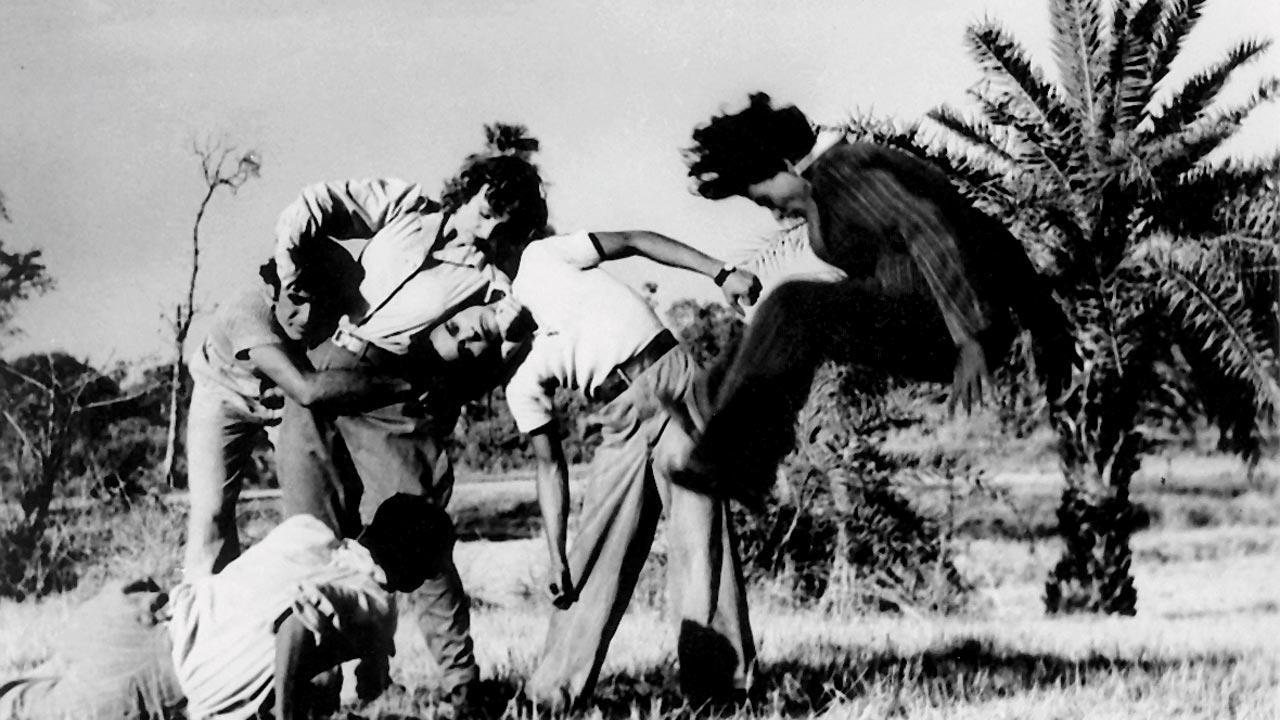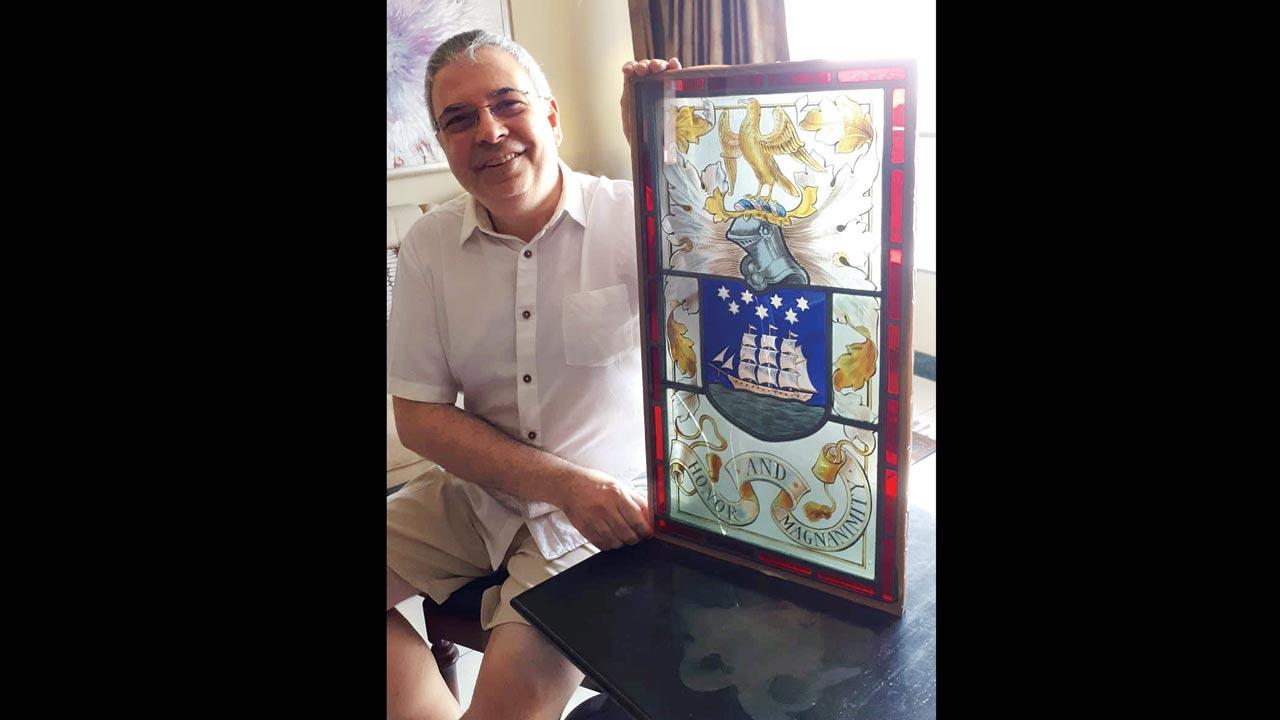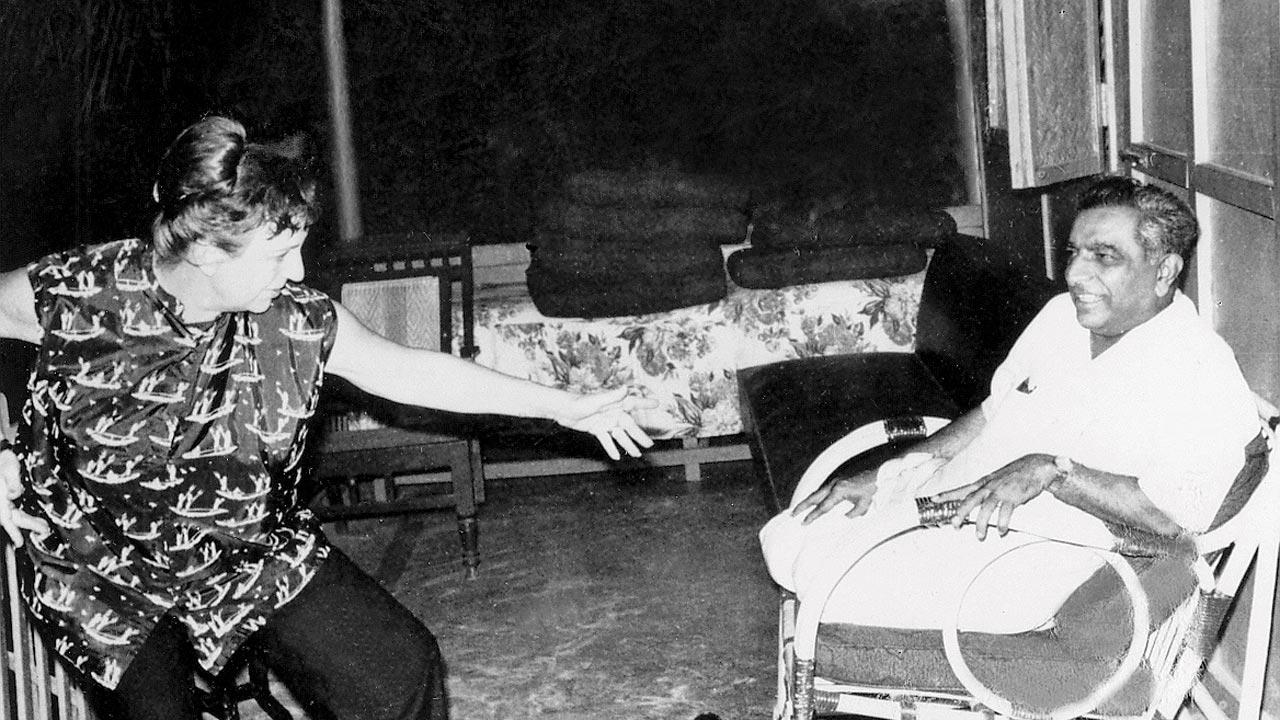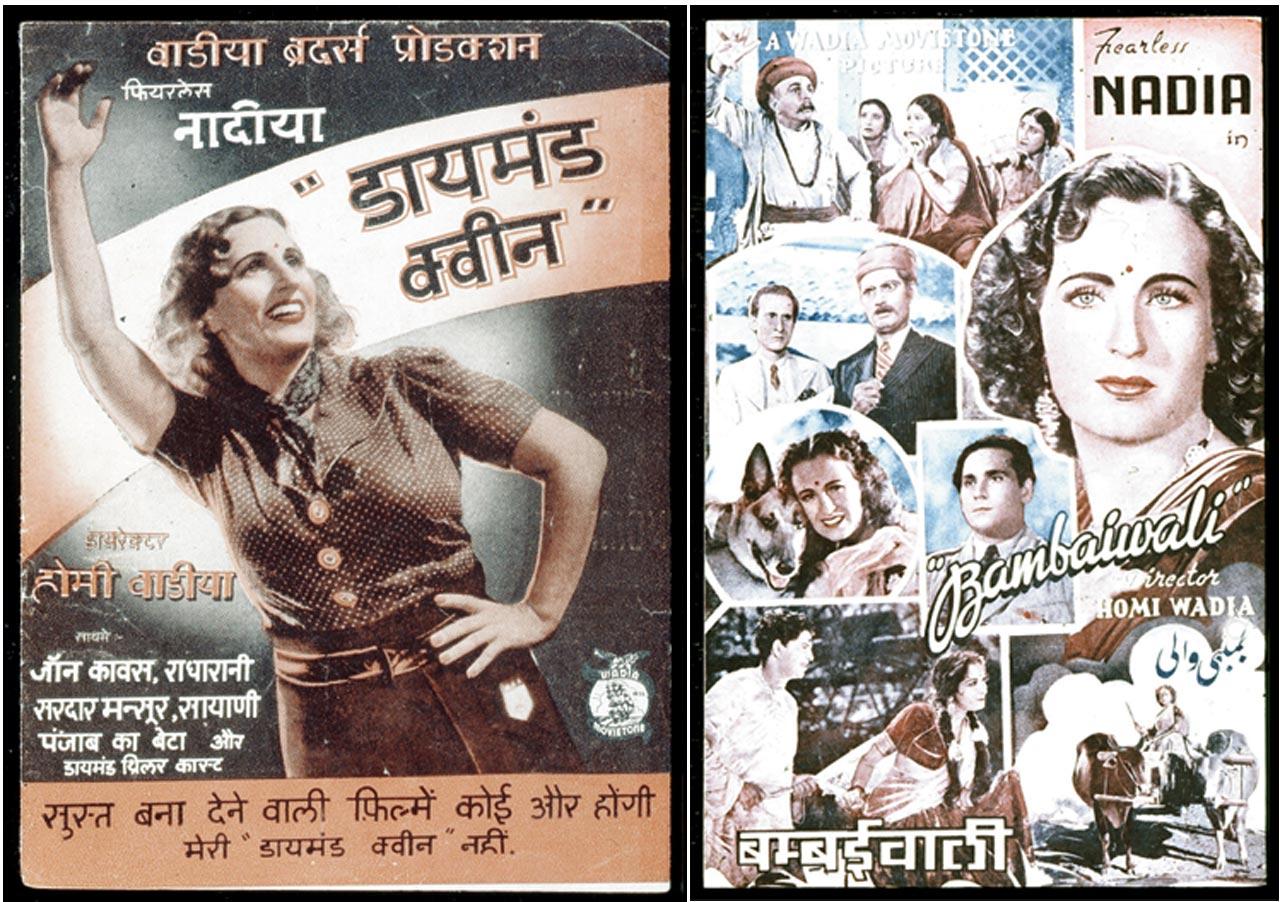An upcoming Prinseps auction of Wadia Movietone memorabilia will highlight the company’s cult films. We trace the Bombay journey of the studio stunt queen, Nadia

Nadia fighting multiple male adversaries in a stunt sequence shot at Wadia Movietone/Basant Films Studios, Chembur
 She came, she cartwheeled, she conquered. And signalled trends beyond flamboyant show-womanship, to create socio-cultural history.
She came, she cartwheeled, she conquered. And signalled trends beyond flamboyant show-womanship, to create socio-cultural history.
ADVERTISEMENT
Mary Ann Evans, aka Nadia (1908-1996), ruled as India’s top celluloid action heroine from the 1930s. Known as the whip-cracking, masked do-gooder in the country’s first ever potboiler to feature a woman vigilante, she stood for a great deal more.
 Grand-nephew Roy Wadia with the stained-glass window bearing the family crest (incorporating the famed ship emblem) from Lovji Castle
Grand-nephew Roy Wadia with the stained-glass window bearing the family crest (incorporating the famed ship emblem) from Lovji Castle
“Using subversive methods, she fought for freedom and for women’s rights in her films… She was a shimmering mixture of action, eroticism and progressive ideas, this rare combination rendering her exemplary modern to this day,” writes Dorothee Wenner in Fearless Nadia: The true story of Bollywood’s original stunt queen.
Translated from the German by Rebecca Morrison, the book pursues the actress’ personal and professional trajectory, running parallel with the city’s mid-20th century zeitgeist.
 Mary and Homi Wadia at one of the legendary parties in their Juhu shack
Mary and Homi Wadia at one of the legendary parties in their Juhu shack
How exactly did Hunterwali/Hurricane Hansa/Himmatwali wow Bombay? Where did she live and work here? A riveting story vaulting across continents contextualises this.
Perth-born to a Scottish father and Greek mother, she learnt the dances of his land and soulful songs of hers. To those inherited talents she added athletic prowess, matching daredevil attitude with lithe grace.
 Posters of Diamond Queen and Bambaiwali, iconic 1940s films starring Nadia, born Mary Ann Evans. Pics Copyright Wadia Movietone/Roy Wadia
Posters of Diamond Queen and Bambaiwali, iconic 1940s films starring Nadia, born Mary Ann Evans. Pics Copyright Wadia Movietone/Roy Wadia
Sent sailing to India in World War I, army man Herbert Evans’ regiment was stationed on Elephanta Island when Mary was just four. Stepping on to Bombay’s new Ballard Pier with the little girl, her mother Margret hoped their destination proved its reputation of more broadmindedly welcoming foreigners than other towns.
Cooped in a Colaba flat, Margret worked as a textile factory seamstress. Herbert’s death, in the 1915 offensive against German troops in Reims, resulted in Mary being admitted to a boarding school on Byculla’s Claire Road.
Abandoning her education to join relatives in Peshawar, she and her mother boarded the Frontier Mail (the legendary train partially titled her 1936 thriller, Miss Frontier Mail). There she adroitly picked up the adventurous skills of horseback riding, rifle shooting, fishing and acrobatics.
Circumstances forced them to return, Mary now with a son, Bobby, to support. Job stints as a law firm secretary and clothing department salesgirl in the Army & Navy Store at Kala Ghoda excited her less than employment with Russian dancer Madame Astrova’s travelling troupe or training in gymnastics to be a Zarko Circus trapeze artist.
An Armenian fortune teller suggested she assume another name for luck, beginning with the letter N. While she toured the country with revues replete with music, mimicry, slapstick and sporty feats, she was spotted by a Lahore cinema owner. He recommended an address of Bombay associates: the film studio of the Wadia brothers.
Jamshed ‘JBH’ Wadia, great-grandson of master shipbuilder Lovji Nusserwanji Wadia, founded Wadia Movietone in 1933. He was influenced by the Lumieres, Douglas Fairbanks and serial stars Pearl White and Helen Holmes. Nadia met JBH and his younger brother Homi at their company headquarters, Lovji Castle in Parel—subsequently converted to V Shantaram’s Rajkamal Kalamandir.
The Wadias admired the cool assurance with which the statuesque, blue-eyed blonde promised her willingness to attempt anything once on screen. She exuded the potential for parts far distant from submissive feminine stereotypes abounding in the industry.
After minor roles in Lal-e-Yaman and Desh Deepak, with focused tutoring in Hindustani diction, in 1935 she delivered a huge hit as the Hunterwali lead.
Hunterwali fever raged wild and wide, gripping pan-Indian fans. Actresses like Padma had earlier essayed action parts, but their appointed doubles ran risks in dangerous situations. Desi audiences were stunned by a white woman who performed her own stunts, tamed lions, fought bandits and bad boys with equanimity and elan.
Instead of the usual coy damsels in distress, she expertly wielded swords, fell from roofs, swung from chandeliers and jumped from speeding locomotives with practised insouciance.
The Wadia find grew to be the gold mine of their studio and exulted that JBH publicised her as the Indian Pearl White. She said, “In a Perils of Pauline sequence, Pearl drives a race car fast to save the hero from spies. In Bombay at that time there weren’t many cars and even fewer women driving them. I was inspired to try.”
Rolls Royce ki Beti, the famous stunt car (actually an Austin), featured in several films. Boasting neatly multiple uses—the camera was sometimes perched on it—the vehicle leapt to life at Nadia’s precisely aimed kick to its body and not the switch-on ignition. Moving driverless posed no problem and in Lutaru Lalna, Nadia had it jolt up dramatically to slice the air.
The emotional angle was trickier. Yet, Nadia pulled off a challenge bigger than the saint-whore tightrope that her 1940s colleagues tiptoed on. With her ample figure limitedly clad, to facilitate the trademark muscle flexions, producers decided to downplay overt sexuality with a casting foil. Actor John Cawas portrayed her assistant in combat, only mildly attracted to her. Asked why this pair were not wed in the end reel, Homi replied, “It simply wasn’t necessary.”
Her real-life hero was, of course, Homi. Their romance remained clandestine because of vehement opposition from his mother Dhunmai and sisters, one of them being Shiamak Davar’s grandmother. The conservative ladies dreaded murmurs about the affair in elite circles.
On the sets, Nadia’s black humour and bravery deeply impressed Homi. “Madame Astrova taught me never to give in to a fight, but face it and break it,” she declared. Fight she had to, in a different way, for her love. They did not marry till 1961, after Dhunmai passed away.
“They were the most romantic pair, way into their nineties,” says Haidar Ali, actor son of Nadia’s close friend, model-actress Pramila. Excelling as a Westernised vamp, Pramila was Esther Abraham, the first Miss India in 1947. “In their bamboo shack under the Juhu beach palms, Homi Uncle and Aunty Mary hosted fantastic Xmas Eve parties. He dressed as Santa with the best false nose and most real-looking beard. Remember, the Wadias were kings of special effects.”
As a kid, their grand-nephew, Wadia Movietone principal director, Roy Wadia (his father Vinci was JBH’s son), was fascinated by the Father Christmas guises Homi donned. “They could refer to contemporary events. During the 1972-73 oil crisis, he arrived as Claus on a camel. On other occasions we gathered at the cottage for lunch, or Housie, with drinks and dancing.” His mother Nargis recollects, “A kind uncle and aunt, Homi and Mary took care to organise games in the sand for the children, like egg-and-spoon or potato sack races.”
Weeklong, the couple shuttled between three residences with their major domo John. Monday to Wednesday they stayed in Munira Lodge on Convent Street in Colaba. Thursday till Friday evening was at the Chembur bungalow. It skirted Basant Studios, which Homi established in 1942, launching the Basant Pictures banner. (Despite creative differences seeing the brothers go separate ways from then, both continued weighing in on each other’s projects.) Saturday and Sunday were reserved for relaxing and socialising in Juhu.
Some afternoons were spent at their regular adda, the home of Ruby Myers, popular as Sulochana, the Silent Era’s first female superstar. They indulged in spirited rounds of rummy over high tea with card-player buddies Pramila and the veteran villain KN Singh.
The Wadias frequently dined out with friends like Edna and Brij Nayar at Bombay Gymkhana, Gaylord, Sea Lounge and Ambassador Hotel for steak, or ordered meals from Frederick’s behind the Regal.
They were also fixtures at the Mahalaxmi racecourse.
At 60, Nadia staged her comeback as a sassy secret agent in the James Bond-inspired Khiladi, premiering at Super on Grant Road, the cinema the family considered auspicious for their success. Its memorabilia are among the posters, lobby cards and song booklets at Prinseps auctions. The artefacts belong to the estate of Riyad Wadia, Roy’s late brother who made the 1993 documentary, Fearless: The Hunterwali Story.
That flick, catapulting Nadia to fame, was by no means her favourite. Diamond Queen was. JBH agreed. The 1940 production’s storyline—reflecting the revolutionary thought of MN Roy whose activist philosophy he was drawn to—resulted in a quite complete piece of filmmaking. Nadia’s foreignness allowed her to acceptably mouth pronouncements advocating independence from colonialism and chauvinism alike. The tagline of Bambaiwali declared, “Hush, Nadia is coming. The woman who makes men blush!”
All her movies roused mounting anticipation as they neared release dates. Girish Karnad recalled his schoolmates sense the charged atmosphere when any stunt film was announced. “We prayed that it would be a ‘Nadia’ or a ‘Wadia’ film. The words were deliciously interchangeable for us.”
Author-publisher Meher Marfatia writes fortnightly on everything that makes her love Mumbai and adore Bombay. You can reach her at meher.marfatia@mid-day.com/www.meher marfatia.com
 Subscribe today by clicking the link and stay updated with the latest news!" Click here!
Subscribe today by clicking the link and stay updated with the latest news!" Click here!







